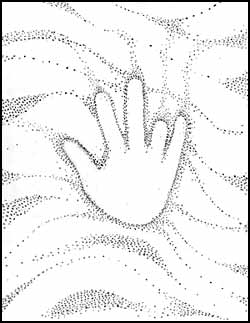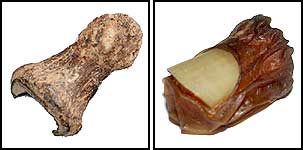 |
Our masters (the spirits) keep a zealous watch over us, and woe betide us afterwards if we do not satisfy them! We cannot quit it; we cannot cease to practise shamanic rites.– Shaman quoted by Wenceslas Sieroshevksi, 1896
|
Welcome to the BME Cultural Corner.
My name is Blake of The Nomad Precision Body Adornment and Tribal Art Museum. This new section of BME/News will focus exclusively on the historical and cultural aspects of bodymod in a traditional context. Personal narratives, stories, articles, rare photos, and new scientific discoveries relating to the endless human need to alter the body will be found here. In introduction, I am a piercer of fifteen years, museum curator, and self-educated anthropologist. I have also authored a new book (A Brief History of the Evolution of Body Adornment in Western Culture) which is available here on BME. My interests are purely traditional culture — one might call me a conservative democrat, as far as bodymod goes.  |
|
 |
The subject of this first article of the Cultural Corner will be amputation — a subject, I admit, I never thought I would be writing about in a historic context. Only lately associated with the bodymod community, and profiled in a recent one-hour Discovery Channel special as well as Shannon’s book Modcon, deliberate amputation is generally misunderstood. It can be said that amputation is not ornamentation (unless you wear a severed digit in your earlobe), more exactly, it is augmentation.
Randomly ask any amputee today about the nature of their “disfigurement” (ignoring all of the social idiums on couth), and expect one of several primary answers — assuming you haven’t pissed them off or trodden on some painful part of their life better left alone.
Our first hypothetical example: A legless man in a wheelchair — mid 50’s — perhaps he lost them on a mine in Vietnam, his “mobility and vitality” stolen from him in his youth by the “enemy”… non-consentually.
Next, an older man (yes, women can be amputees too) missing a forearm and a hand… his whole life haunted by the feeling that with both hands he is incomplete as a person until that appendage is sacrificed. Consumed with a deep, unnameable need to remove part of the anatomy considered essential — perhaps an “accident” with a Skilsaw — and now he is content… an indescribable inner part of himself somehow satiated.
For our third example we turn back the hands of time (no pun intended)… about 30,000 years! The place is a dark cave in Paleolithic Europe. With the entire clan in attendance — spellbound — an elder shaman severs a digit from his hand. Does he hate himself? No. Does he have issues? No. The primitive mind and developing psyche of humanity is consumed wih offerings of magic, sacrifice, the spirit-world, and the animal kingdom, upon which he depends for survival.
 Amputated finger tips. Left: 30,000 years old (© Pawel Valde-Nowak), right: 6 years old (from BME’s collection). |
What is transpiring in the cave is one of earliest known forms of “religious rite” or spiritual practice and enactment of ritual. In fact, discoveries at Oblazowa, a Paleolithic site in Poland have sparked a huge controversy in the world of prehistoric art. Known to science, yet rare, are hand-stencils on the walls of Paleolithic European caves with missing digits. This “Amputee Art” was previously regarded as examples of illness, accidents or a strange system of communication — until now.
New evidence has unearthed (in the same caves that housed the amputee art): a thumb phalanx, and other human finger bones found in association with shell pendants, stone beads, the perforated teeth of an Arctic fox, a Mammoth tusk boomerang (the oldest boomerang ever found), and other ritual objects. They date to more than 30,000 years ago.
Pawel Valde-Nowak, the scientist who excavated the site believes that this proves that “fingers were amputated in a ceremonial context” and that amputee art gives “depictions of hands (with missing digits) a very particular symbolic meaning”.
Even with our imaginary time-travel, early language, grammar, and syntax prevent the modern mind (if we could ask) from communication with the shaman in the cave. “Why?” we might inquire, yet the ritual context of this ancient amputation lets the scientific mind extrapolate, respect, and appreciate the ceremonial, even religious rite associated with the ancient amputation.
 Amputations. Left to right: Performance artist Roger Kaufman who has changed the length of nearly all his fingers and toes (photo: Efrain Gonzalez), healed amputation with original finger tip (photo and model: Jerome Abramovitch), and an “amputation party” in Russia (both photos: BME archives). |
With scientific evidence substantiating this new theory, further conjecture will be limited only by lack of further archaeological evidence… in the art world, the controversy will likely continue for decades to come. Now science has established ritual amputation to the earliest days of modern man and dated the practice to Paleolithic times, paralleling the emergence of humanity’s oldest forms of ritualized ornamentation and adornment; piercing and tattooing.
Amputation, drugs, religion, meditation or ritualized body adornment are means by which we may glimpse the divine, or, that which is greater than the sum of our “parts”. These vehicles of transcendental experience are doorways to an ancient state of mind. To borrow a quote from my book, “the ways by which we find release and transcendence as a species are varied, indeed.”

Blake

Blake Perlingieri is a body piercer of fifteen years, a museum curator, and a self-educated anthropologist. He is the author of A Brief History of the Evolution of Body Adornment in Western Culture and can be found online (and offline) at nomadmuseum.com.
Copyright © 2003 BMEzine.com LLC. Requests to republish must be confirmed in writing. For bibliographical purposes this article was first published December 17th, 2003 by BMEzine.com LLC in Tweed, Ontario, Canada.
 BME/News and Modblog highlight only a small fraction of what
BME/News and Modblog highlight only a small fraction of what
Great insights here on this site and I like your take on things. One thing I have witnessed is what we think about is 100% what we get. We create our own reality.
Great insights here on this site and I like your take on things. One thing I have witnessed is what we think about is 100% what we get. We create our own reality.